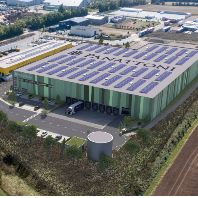Germany’s logistics real estate market is showing first signs of recovery. For one thing, the transaction volume picked up some steam during the first half of 2024. Nonetheless, prime net initial yields increased by another ten to twenty basis points because the price correction had not fully run its course yet. Transactions focus predominantly on the value-add segment. Prime rents in Germany increased by an average of 1.8% during the first half of 2024 and thus slightly faster than the European average.
These are the findings that GARBE Research presented in its latest GARBE PYRAMID MAP, the 2024 mid-year update of the company’s overview of prime rents and prime net initial yields for the 116 most important logistics real estate submarkets in 24 European countries.
Author Tobias Kassner, Head of Research and a member of the Management Board of GARBE Industrial Real Estate said: “The German logistics real estate market was mainly defined by stabilisation during the first half-year. But certain markets nonetheless registered a substantial growth of prime rents.”
Dr Peter Bartholomaus, Head of Fund Management & Capital Markets and member of the Management Board at GARBE, elaborated: “While the transaction volume still fell short of the long-term average during the first half of 2024, it did exceed last year’s figure. Especially portfolio transactions are gaining significance in this context. At mid-year, yield levels in the top logistics markets ranged from 4.9% to 5.0%. Yield rates in logistics regions beyond the top markets varied between 5% and 6%.”
For the second half-year, GARBE analysts predicted a stable sideways movement of yield rates, with investment activities assumed to grow on a low level.
GARBE PYRAMID Forecast Lays Ground for Target-Oriented Strategy
For the first time, a forecast developed together with Oxford Economics was added to the GARBE PYRAMID map.
The assessment of the current situation is important for accurately identifying market opportunities and risks. However, it's only through a well-informed forecast that you can develop a precise strategy.
The forecast presents a five-year projection for the trends in prime rents and net initial yields in 30 selected top logistics regions across Europe, considering a wide range of macroeconomic and market-specific factors.
Key German logistics market insights include the following: Prime net initial yield rates have been steadily declining for over two years, and they are expected to decrease significantly before 2029. The predicted decline in yield rates for the top German markets during this period ranges from 100 to 120 basis points each. According to our forecast, demand for logistics facilities is set to increase in the coming years. However, due to persistent supply shortages, particularly in the top markets, this will lead to a decrease in yield rates. Even by the end of the forecast period, we anticipate that the yield levels of early 2022 will not have been regained, indicating the period before the price corrections took effect.
The background to this, in his opinion, is the permanently increased level of base rates and investment alternatives such as German government bonds.
Germany’s Occupier Market Showed a Modest Gain at 1.4m m2 in Q2
Take-up in the German occupier market for logistics real estate c. 2.4m m2 by mid-year 2024. That is 16% less than the prior-year result and 25% below the long-term average.
“This trend is similar in all sectors and areas because Germany’s weak economy is increasingly dampening demand,” explained Adrian Zellner, Head of Business Development at GARBE. “Demand among logistics service providers has dried up faster than it did in the industrial and retail sectors.”
The vacancy rate has ascended from a historic trough to an average of 3% nationwide. What has kept the vacancy rate from rising rapidly in many places is the low-level building activity.
“The degree of differentiation between the markets has noticeably increased again,” Zellner emphasised. While top markets like Munich and Hamburg show virtually no vacancies at all, vacancy rates in markets like Bremen and Leipzig have surged lately. “In Leipzig, several speculative developments will come on-stream soon that the market will be unable to absorb right away and that will drive up local vacancies,” Zellner elaborated.
During the first six months of 2024, prime rents grew particularly quickly in Munich (+7.1%) and Mannheim (+5.9%). In fact, the two cities are among the top five across Europe. That is because persistently strong demand coincides with a very limited supply here. Other cities with very substantial rent hikes include Karlsruhe (+4.3%), Duisburg (+4.0%) and Nuremberg (+3.9%). At €12.00/m2, by far the highest prime rents were still charged in Munich. Next in line were the other top markets, the going rates being €8.70/m2 in Stuttgart and €8.60/m2 in Berlin, Dusseldorf and Hamburg.
“With a view to the years ahead, we assume that prime rents in the top markets will keep going up. This is particularly true for 2026 and the years thereafter. By then, the German economy should have bounced back, according to our forecasts, while land prices, construction costs and financing costs will remain elevated,” as Kassner explained. Especially in the top markets, rising demand will be confronted by limited supply.
For more figures and methodological details, please see the interactive GARBE PYRAMID MAP . The data referenced in our press release are sourced from the PYRAMID project.
Image source - Pexels.
Europe Real Estate — an overview of real estate developments in European countries.















